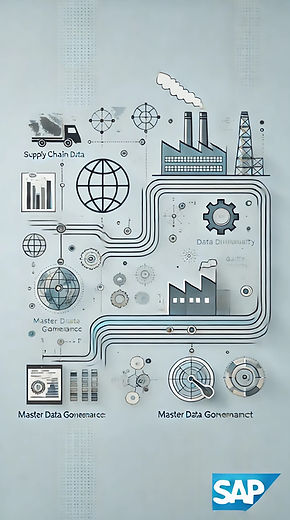
S/4HANA Implementation - ongoing
Global SAP S/4HANA Implementation – Enterprise Data Migration Leader (20+ Countries)
Challenge
Led the data strategy and execution for a multi-year, enterprise-wide SAP S/4HANA implementation spanning 20+ countries and multiple business units across all functional domains. The initiative aimed to ensure seamless data integration while enabling the company’s digital transformation and harmonizing global operations.
Approach
-
Defined and executed a comprehensive data migration strategy encompassing ETL processes, data validation, cleansing, transformation, and load sequencing aligned with business readiness.
-
Acted as the central point of coordination between business stakeholders, IT leadership, system integrators, and development teams to ensure alignment with enterprise architecture and transformation goals.
-
Provided strategic leadership to a distributed, cross-functional team, driving delivery under tight timelines and complex regional requirements.
-
Embedded proactive risk identification and mitigation practices to safeguard critical data assets and ensure continuity throughout all migration phases.
Outcomes & Achievements
-
Enhanced data quality and integrity across the enterprise by implementing robust validation frameworks and harmonization strategies, reducing inconsistencies and duplication.
-
Aligned data migration deliverables with broader digital transformation and ERP modernization goals, ensuring seamless functional integration.
-
Developed and executed a migration-specific program roadmap, enabling leadership visibility into milestones, risk areas, and cross-functional dependencies.

PLM Implementation

Global Product Lifecycle Management (PLM) Rollout – Enterprise Product Data Transformation
Challenge
Legacy systems and fragmented processes led to the use of incorrect materials, inconsistent packaging information, and non-standardized references. Multiple ERP instances created conflicting “sources of truth,” undermining product safety, data traceability, and technical accuracy. High reliance on manual workarounds and offline approvals resulted in delays and compliance risks.
Approach
-
Led the global rollout of a Product Lifecycle Management (PLM) solution to R&D, SQRC, and site-based users, establishing a unified framework for managing core product design data (Materials, BOMs, Specifications).
-
Designed and deployed global processes for foundational product data management, enabling ERP integration and “single source of truth” governance across product hierarchies.
-
Standardized data structures and approval workflows to reduce rework, eliminate manual interventions, and enhance cross-functional transparency.
-
Interfaced PLM with ERP systems to ensure consistent and traceable product information from concept to commercialization.
Outcomes & Achievements
-
Achieved up to 30% improvement in end-to-end product development cycle time, accelerating speed to market.
-
Delivered a 5x productivity increase by reducing manual rework and increasing automation across product data flows.
-
Improved data quality and regulatory compliance by ~40%, enabling more reliable decision-making and product safety assurance.
SAP ECC and MDG Implementation
Post-Merger Data Integration & SAP MDG Implementation – Supply Chain Domain Consolidation
Challenge
Following a major acquisition, a top 10 global retail manufacturer faced the challenge of integrating supply chain master data from a Brazilian factory into its enterprise SAP ecosystem. The legacy systems lacked consistent data structures, governance controls, and quality standards—posing risks to operational continuity, procurement accuracy, and regulatory compliance.
Key issues included:
-
Incomplete and incompatible data models between legacy and SAP systems
-
High levels of data duplication, inconsistency, and quality degradation
-
Absence of unified data governance policies or ownership frameworks
Approach
-
Led comprehensive assessment of business-critical data elements, definitions, and technical metadata to guide mapping and transformation into SAP standards.
-
Revalidated user requirements and coordinated system-wide change impact assessments to ensure seamless integration into existing workflows.
-
Conducted end-to-end testing, including performance, regression, automation, and UAT, to ensure full operational readiness.
-
Designed and implemented SAP MDG to institutionalize data governance standards, automate validation rules, and assign clear data ownership across functions.
-
Reviewed and strengthened enterprise-wide policies for data quality, metadata management, provisioning, and reference data integrity.
Outcomes & Achievements
-
Seamless data migration with 100% accuracy for critical data elements, enabling uninterrupted operations post-integration.
-
Data quality uplift through elimination of duplicates and inconsistencies, achieving harmonization across supply chain master data.
-
Improved operational efficiency in planning, procurement, inventory, and distribution processes through unified, trusted data in the SAP environment.

Snowflake Analytics for Advance Planning Solution

Enterprise Supply Chain Data Integration & Snowflake Cloud Analytics Enablement
Challenge
The organization aimed to harness Snowflake’s cloud-native data platform to enable advanced production planning, global allocation forecasting, and external data productization. However, fragmented IT landscapes across factories, with multiple ERP systems and inconsistent master data, created a major roadblock to unified insights and operational agility.
Specific issues included:
-
Fragmented data sources (SAP and legacy ERPs) and inconsistent master data definitions
-
Absence of standardized production planning structures (e.g., Work Centres, BOMs, Routings)
-
Performance limitations and inefficiencies in handling massive data volumes (~10M records)
-
Lack of reliable and timely data to support cross-functional planning and decision-making
Approach
-
Led an enterprise-wide initiative to consolidate and cleanse operations and supply chain master data from SAP and legacy systems for integration into Snowflake’s cloud-based platform.
-
Engineered complex SQL pipelines to ingest, transform, and unify multi-system data feeds into a trusted global data layer to support predictive planning and analytics.
-
Applied prompt engineering and advanced query optimization to ensure scalability, efficiency, and near-real-time data availability for critical planning functions.
-
Collaborated with cross-functional teams across IT, supply chain, finance, and production to align planning structures, metadata definitions, and governance policies.
Outcomes & Achievements
-
Established a standardized and complete data model for Production Planning (Work Centres, Routings, BOMs, and Production Versions), fixing structural gaps across 80% of data sets.
-
Enabled faster, data-driven decision-making in response to supply chain disruptions through enhanced visibility and long-range forecasting accuracy.
-
Achieved measurable cost savings by reducing scrap, transportation inefficiencies, and inventory carrying costs through more intelligent planning decisions.
-
Improved data governance, performance, and security across supply chain operations with scalable Snowflake-based data architecture.